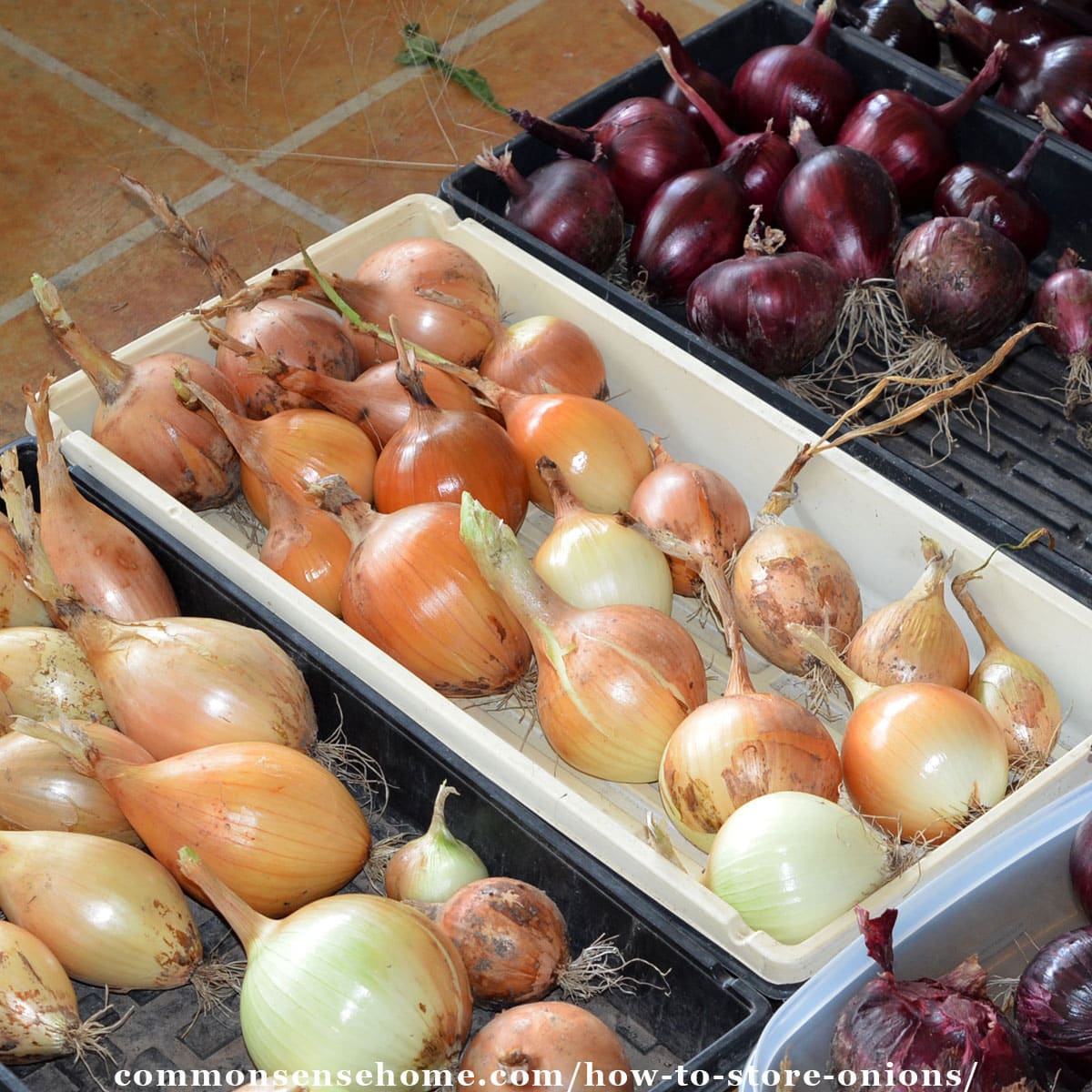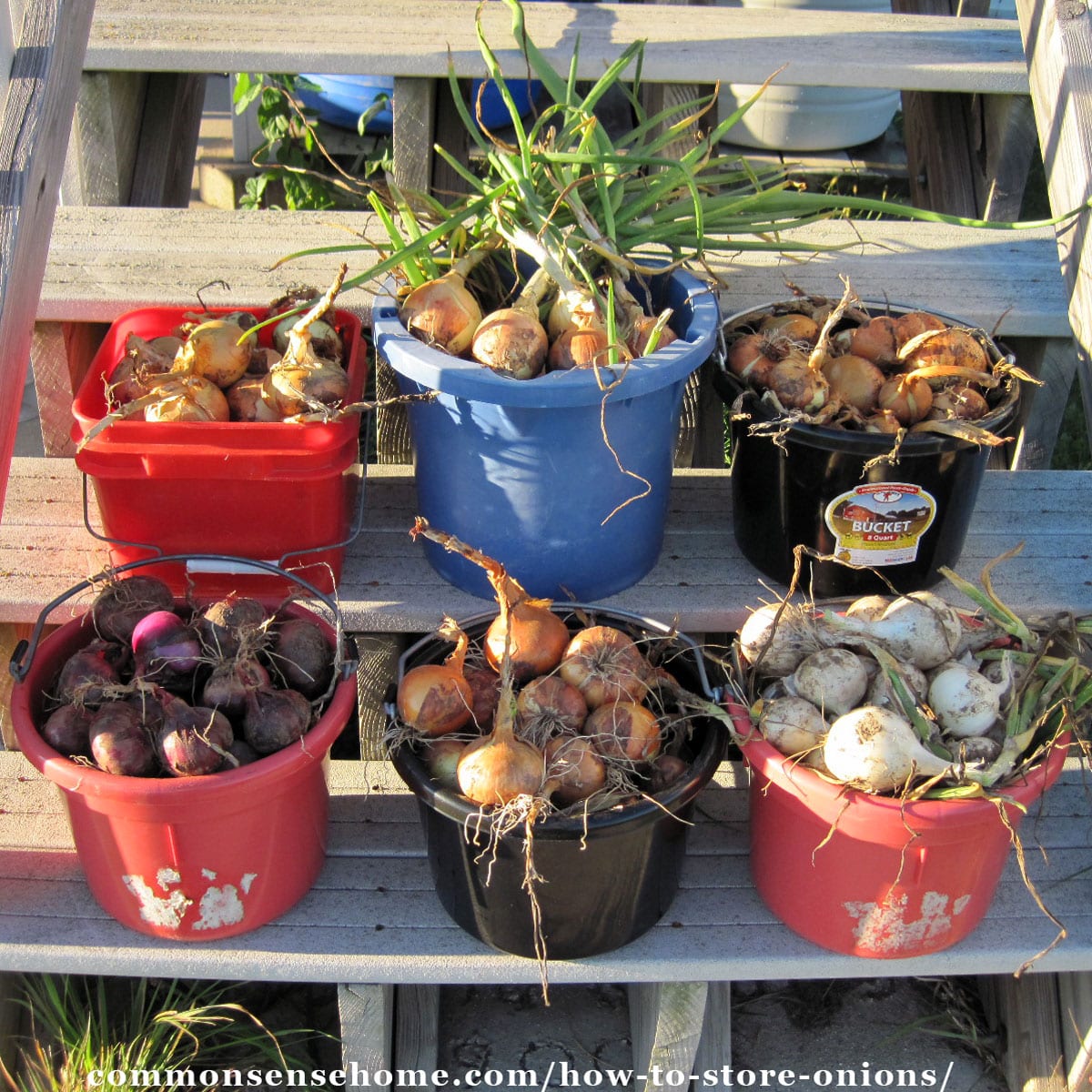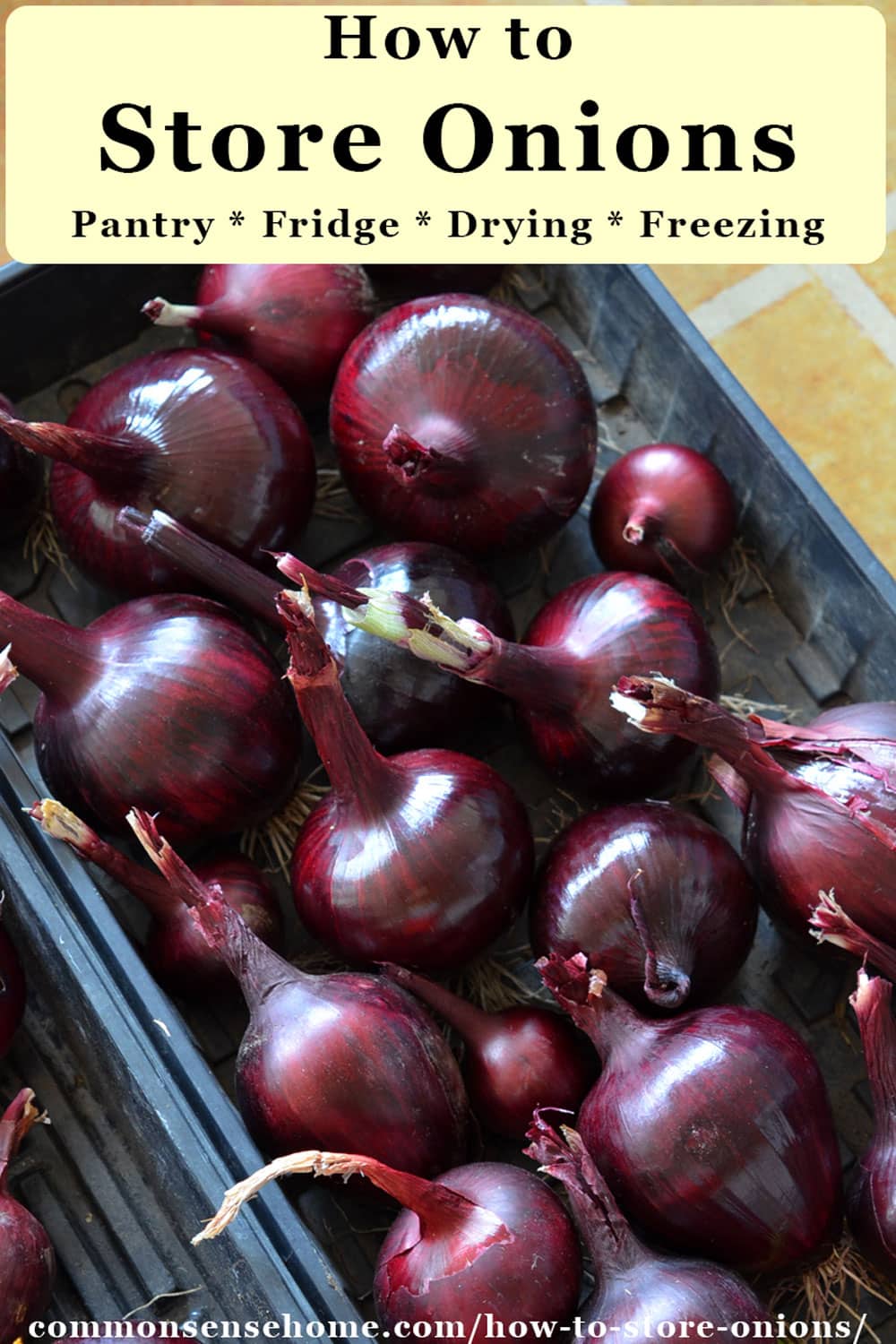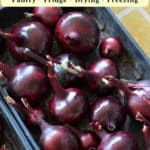How to Store Onions So They Last
This post may contain affiliate links. Read my full disclosure here.
What’s the best way to store onions – on the counter, in the refrigerator, in the freezer, or dried? We’ll share tips to help your onions last for short or long term storage.

For tips on onion harvesting and curing, see “When to Harvest Onions (Plus Harvesting Tips and Best Storage Varieties)“.
Table of contents
How to Store Onions
It’s best to store onions in a cool, dark, dry conditions. Too much moisture and they will rot. Higher temperatures and sunlight can trigger sprouting or rot. Don’t peel the skin off the onion until you plan to use it.
- 35 – 40 ℉
- 60 to 70 percent relative humidity
Air circulation is important, too. Don’t stash them in a sealed plastic bag, unless you’re dealing with cut onions or spring onions. (Read more on this in the refrigerator section.)
We keep most of our onions in trays on upper shelves in the root cellar for long term storage, and a few in a small bin in the kitchen for easy access while cooking. A garage or basement may also work well for longer storage.
Proper storage options include open bins, mesh bags, pantyhose, baking dishes – any spot where you can spread them out and keep watch for spoilage.
Even if your room temperature is a little warm, dry, spicy onions that are cured for storage can hang out for several weeks on the kitchen counter. Don’t keep onions and potatoes in the same container. The onions release ethylene gas, which encourages the potatoes to start sprouting.
Sweet onions don’t keep as well as hot onions. Aim to use them within a week or two of purchase, or freeze or dry for longer storage.

Hanging onions in old pantyhose
Maye C. shared her onion storage technique on the Common Sense Home Facebook page. Hang the pantyhose in a basement, root cellar or other cool, dry location.
Collect lots of used pantyhose. Any full length size. Ask at church or friends.
Drop an onion in tie a knot, add another tie a knot, add another, and so on, until both legs are full. Take to storage area hang over a nail at the crotch. Repeat with more hose until done.
To use, start at the toe and cut below the knot and remove the onion. Just remember to remove onions off of each leg, so it will keep hanging even on the nail.
My mother taught me this over 40 + years ago. This really saves on space. And you can keep track of usage at a glance. Also on quality if one starts to go bad, you can remove it and use it quick.
How long do stored onions last?
- Countertop – 1-2 weeks for sweet onions, weeks or even months for storage onions
- Refrigerator – use cut onions within 7-10 days
- Stored in a cool, dry location (root cellar, basement, garage) – 1mo to 9months (varies) – depending on temp, moisture and onion variety
- Frozen – use within 6 mouths to 1 year
- Dehydrated – best used within 5 years, may last up to 15 years.
- Freeze Dried – best used within 10 years, may last up to 25 years.
How can I tell if an onion is bad?
If the onion is mushy or discolored, has visible mold, or has a bad smell, the onion is probably spoiled.
If your onions sprout, they are still safe to eat, but the flesh will start to get soft. You can use the sprouts like green onions.
Should onions be refrigerated?
Don’t put storage onions (the ones with the thick, dry peels) in the refrigerator, unless they’ve been peeled or cut. The refrigerator is too humid, and they will spoil faster than they will in cool dry conditions.
Once your onions are peeled and/or cut, then refrigerator storage is recommended. Store peeled, sliced or diced onions in bag or airtight container, and use within a week or so. As they sit, cut onions get more pungent.
Would you like to save this?
Green onions and other tender alliums like garlic scapes and chives benefit from refrigerator storage. Wrap green onions in a damp paper towel, and tuck the wrapped onions in an airtight container. Use them within 7-10 days for best quality.
Sweet onions keep best in a cool, dry, dark location, just like storage onions, but they don’t last as long. If you don’t have a better spot elsewhere, wrap individual onions in dry paper towel or newspaper in the refrigerator to extend shelf life.
Can you freeze onions for storage?
Yes, you can store onions in the freezer, but once frozen, they get soft, and are best used for cooking.
To freeze onions, chop or slice peeled onions and pack into an airtight container. You can freeze the onions on a tray first, and then pack then into the container to make them easier to pour.
If you want to use plastic storage bags, I recommend using two layers, as the onion smell tends to spread and may give other items an “off” taste. Freezer safe glass containers keep onion smells locked in. You can use plastic freezer containers, but they may pick up onion smell.
Sometimes I cook my onions before freezing, and freeze them in amounts that I use for recipes to save prep time later. Simply cook up a mess of onions, then scoop them into 1/2 cup portions onto a tray to freeze. Pack the scoops into one or more airtight containers for storage.
How to Dehydrate Onions for Storage
To prepare raw onions for dehydrating, peel and slice or chop into pieces of uniform thickness. No pretreatment is necessary before drying. Thinner pieces of sliced onions will dry more quickly.
Think about how you are likely to use the onions after drying, and cut to size. Spread onions evenly on drying trays, and dehydrate at 125 – 135 ℉ until leathery/brittle. I usually load mine up in the evening and dry them overnight.
You may want to dehydrate in a garage or out of the way location, as the drying onions are quite fragrant. To reduce odor, you can caramelize the onions before drying, but avoid fats or oils, which are more likely to spoil in storage.
Store dried onions in an airtight container. See “How to Dehydrate Vegetables” for more information on storing dried veggies.
Freeze Drying Onions
You can freeze dry either raw onions or cooked onions in a home freeze dryer. Prepare the onions for freeze drying like you do for dehydrating.
Once dry, store the onions in an airtight container with oxygen absorber. Properly freeze dried onions will last 10 to 25 years.
You can pulverize your dehydrated or freeze dried onions in a blender or food processor to make onion powder. It’s best to make it in small batches, as it will clump because it contains no anti-caking agents.
If you add a reusable desiccant packet to your container of dried onions or powder, it will help prevent clumping.

Related Articles
- How to Grow Onions
- When to Harvest Onions
- Why do onions make you cry?
- Onion Pudding
- Browse all of our Food Storage Articles
Originally published in 2013, last updated in 2022.


Instead of tying a knot between onions could you use clothespin, or would it slip off? That way you could remove the onions from the top down, and save the pantyhose for next year.
It should work, if your onion stems and clothespins are sturdy enough. A belt or cloth strip might even work better, as the pantyhose will tend to stretch as they get loaded up.
Thank you for the best detailed information I have seen anywhere. Better than a book!! The sharing of your huge expanse of knowledge through experience is greatly appreciated. Wow!
You’re welcome.
This is so helpful! Thank you for sharing!
You’re welcome.
We live in Northern Wisconsin just west of Tomahawk. We’ve had a very wet season and pass result the onions are very muddy. My husband feels mud should be washed off before drying and I think the mud dry before drying. We have a good crop and want to have then all winter long. Which is better.
I’d probably air dry and they brush off the mud. Whether you’re rinsing or dipping, there’s more chance for the water and mud to work under more layers of skin.
Onions have been one of my most successful crops while learning how to garden up North and I got a number of great ideas and insights from reading this article. Where I am it can be very wet fairly late into spring, so planting is often delayed until the annual flood subsides and the raised beds in the high spots are accessible again. My first onion bed (started from bulbs) was just starting to fatten up when we had our first hard frost. Not knowing a thing about how to mulch onions, and thinking straw would crush the leaves, I stood flattened cardboard boxes around the sides, leaning them against the leaves, then laying flattened boxes over the top. I then overlapped 3″ thick layers of straw around the sides and over the top. This is one tough vegetable! In the spring I pulled everything off and found that the yellow ones had survived best and had grown a little over the winter. I let them grow for a second season. A few went to seed. I didn’t have a place to start the seeds the next winter, but would like to try growing from seed when space permits. The next summer, I planted a good number of onion bulbs around my squash. The squash did well but the onions were too shaded out to grow well. I actually forgot about them until the following spring, when I found them under a much more casual mulch of maple leaves. They survived -35F just fine, grew even fatter and were ready to pull much earlier than those in the previous experiment. The bed where I had the squash was wetter than the first bed I tried. I have read comments about onions being a “marsh vegetable”. If my garden wasn’t so difficult to weed and bed up in spring, I might try just planting in fall this year.
Regarding funky bags of bulbs, have you checked with your local feed store? Ours stocks bins of onions from which we pick out healthy bulbs. The selection is not real fancy, but these onions tend not to rot so readily. I have also heard about varieties of perennial onions that give you green onions over the winter and modest sized bulbs in fall, though you leave a generous number to continue growing growing over the winter. Rhizome grass is a persistent marauder in my garden area, not sure how the onions would fare with the relentless encroachment of the grass under the snow.
The intermittent summer we had this year was hard on crops that usually do much better. Your fabulous bean post has inspired me to try for bigger and better next year. We are also going to try a zip-tie geodesic dome, in the hope that it will withstand wind better than our flyaway hoop houses did. I loved the sight of your Friday harvest and the great crops you pulled in earlier this fall. Thanks, and keep the ideas coming. Sandy
You sound like a messy gardener after my own heart – try stuff out and see what works. I’ve picked spinach and mache that self-seeded out of a snow pile in the middle of winter. This is why my garden is rarely clear or tilled at the end of the season – things are still growing! We are running behind, but the boys and I still need to get a variety of tough crops planted in the new greenhouse. So far there are just a few things we moved inside from the regular garden.
Thank you for all this great info! I grew onions once, but did not have great results, so I will definitely have to try again next year! Love your root cellar!
thanks for the info! question on the hygrolid – do you use that just to check the humidity in the jar, and then use whatever lid you’d normally use? i’m guessing (hoping, as they aren’t cheap) that it’s meant to be used like an instant read thermometer is for the oven.
It’s not instant read – they recommend keeping it in a jar for 48 hours to make sure the moisture levels have evened out to get an accurate reading – but you do use it to check and then seal with your standard lid.
Thanks for taking the time to comment, ladies.
Great info! Thanks!
I have been freezing onions for a long time, but I did not know how to prepare for a root cellar or the temperature. Thank you for the help.